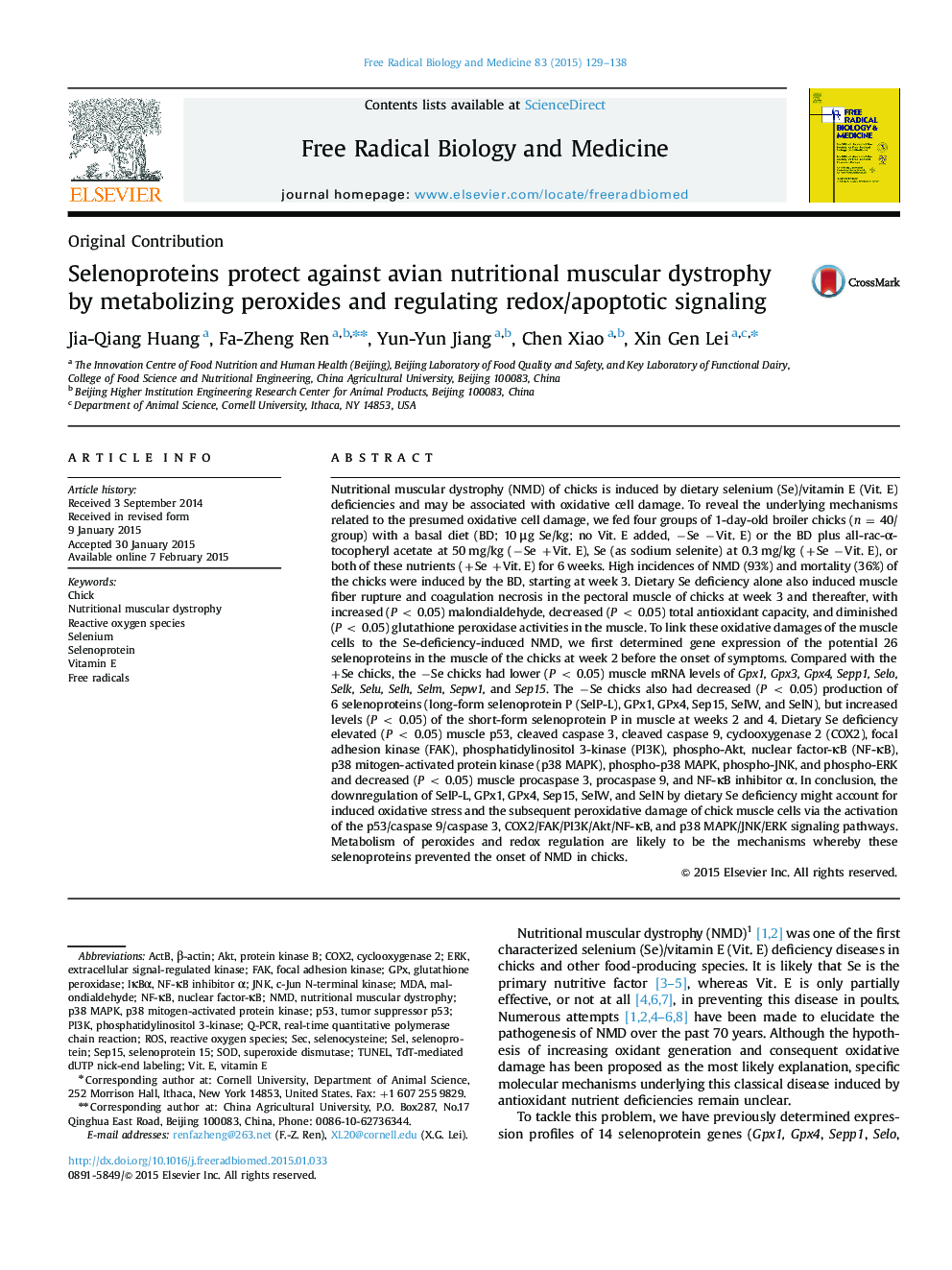| کد مقاله | کد نشریه | سال انتشار | مقاله انگلیسی | نسخه تمام متن |
|---|---|---|---|---|
| 1907959 | 1534959 | 2015 | 10 صفحه PDF | دانلود رایگان |
• Avian nutritional muscular dystrophy (NMD) was induced by Se deficiency to reveal its pathological mechanism.
• Functional expression of 5 selenoproteins in muscle was associated with the onset of the disease.
• Key proteins in 3 redox/apoptotic signaling pathways were activated before the onset of NMD.
• Selenoproteins protected against NMD by mediating peroxides and redox/apoptosis signaling.
Nutritional muscular dystrophy (NMD) of chicks is induced by dietary selenium (Se)/vitamin E (Vit. E) deficiencies and may be associated with oxidative cell damage. To reveal the underlying mechanisms related to the presumed oxidative cell damage, we fed four groups of 1-day-old broiler chicks (n = 40/group) with a basal diet (BD; 10 μg Se/kg; no Vit. E added, −Se −Vit. E) or the BD plus all-rac-α-tocopheryl acetate at 50 mg/kg (−Se +Vit. E), Se (as sodium selenite) at 0.3 mg/kg (+Se −Vit. E), or both of these nutrients (+Se +Vit. E) for 6 weeks. High incidences of NMD (93%) and mortality (36%) of the chicks were induced by the BD, starting at week 3. Dietary Se deficiency alone also induced muscle fiber rupture and coagulation necrosis in the pectoral muscle of chicks at week 3 and thereafter, with increased (P < 0.05) malondialdehyde, decreased (P < 0.05) total antioxidant capacity, and diminished (P < 0.05) glutathione peroxidase activities in the muscle. To link these oxidative damages of the muscle cells to the Se-deficiency-induced NMD, we first determined gene expression of the potential 26 selenoproteins in the muscle of the chicks at week 2 before the onset of symptoms. Compared with the +Se chicks, the −Se chicks had lower (P < 0.05) muscle mRNA levels of Gpx1, Gpx3, Gpx4, Sepp1, Selo, Selk, Selu, Selh, Selm, Sepw1, and Sep15. The −Se chicks also had decreased (P < 0.05) production of 6 selenoproteins (long-form selenoprotein P (SelP-L), GPx1, GPx4, Sep15, SelW, and SelN), but increased levels (P < 0.05) of the short-form selenoprotein P in muscle at weeks 2 and 4. Dietary Se deficiency elevated (P < 0.05) muscle p53, cleaved caspase 3, cleaved caspase 9, cyclooxygenase 2 (COX2), focal adhesion kinase (FAK), phosphatidylinositol 3-kinase (PI3K), phospho-Akt, nuclear factor-κB (NF-κB), p38 mitogen-activated protein kinase (p38 MAPK), phospho-p38 MAPK, phospho-JNK, and phospho-ERK and decreased (P < 0.05) muscle procaspase 3, procaspase 9, and NF-κB inhibitor α. In conclusion, the downregulation of SelP-L, GPx1, GPx4, Sep15, SelW, and SelN by dietary Se deficiency might account for induced oxidative stress and the subsequent peroxidative damage of chick muscle cells via the activation of the p53/caspase 9/caspase 3, COX2/FAK/PI3K/Akt/NF-κB, and p38 MAPK/JNK/ERK signaling pathways. Metabolism of peroxides and redox regulation are likely to be the mechanisms whereby these selenoproteins prevented the onset of NMD in chicks.
Figure optionsDownload high-quality image (151 K)Download as PowerPoint slide
Journal: Free Radical Biology and Medicine - Volume 83, June 2015, Pages 129–138
